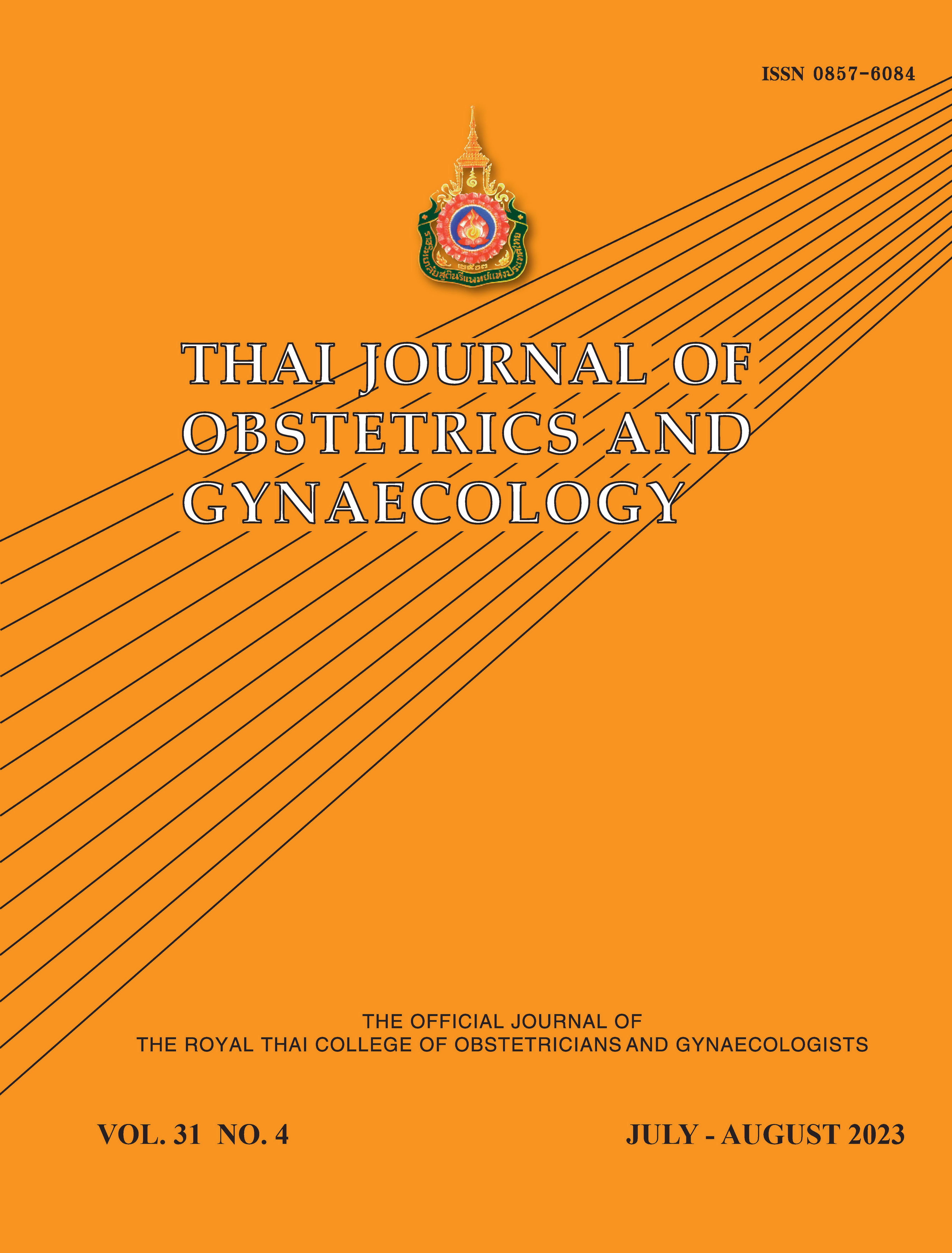Treatments and Outcomes of Endometrial Cancers in Srinagarind Hospital
Main Article Content
Abstract
Objectives: Endometrial cancer was the second most common gynecologic cancer. Despite many standard guidelines, variation of management could still occur. This study was done with the objectives to compare treatments in real-life practice to standard guidelines and oncologic outcomes to quality indicators.
Materials and Methods: This retrospective descriptive analytical study was conducted in 316 endometrial cancer patients registered at Srinagarind Hospital, Khon Kaen University, during 2016-2020. Forty-three patients were excluded and 273 were analyzed. Surgical and adjuvant treatments were compared to standard guidelines. Oncological outcomes were compared to quality indicators. Prognostic factors were also analyzed.
Results: Total hysterectomy with bilateral salpingo-oophorectomies was mostly done in all women (96.3%) and some of them were done via minimal invasive surgery (7.3%). Omentectomies were done in 75.1% and all were negative. Bilateral pelvic node dissection or sampling was done in 51.6%, while 84.9% that should be done in group of those were not. About two-thirds (64.5%) of patients received adjuvant therapies, which 91.5% of their waiting time was within 60 days after surgeries. external beam radiation therapy (EBRT) was done via three-dimensional technique 100%. Over- and under-treatment were found in 16.5% (95% confidence interval (CI) 10.9-22.0) and 19.9% (95%CI 13.9-25.8) of all adjuvant therapies. There was no death within 30 days after surgeries. Three-years overall survival (OS) and recurrence-free survival (RFS) rates were 93.4% and 94.9%, respectively. Significant prognostic factors for both kinds of survivals were stage and residual lesion.
Conclusion: Over- and under-treatment of adjuvant therapy were found in 16.5% and 19.9%, respectively. Oncologic outcomes were good and comparable with others’ despite of low lymphadenectomy rate. However, according to the quality indicators, we had to increase our minimal invasive surgery rate.
Article Details

This work is licensed under a Creative Commons Attribution-NonCommercial-NoDerivatives 4.0 International License.
References
Pilleron S, Sarfati D, Janssen-Heijnen M, Vignat J, Ferlay J, Bray F, et al. Global cancer incidence in older adults, 2012 and 2035: A population-based study. Int J Cancer 2019;144:49-58.
Ferlay J, Ervik M, Lam F, Colombet M, Mery L, Piñeros M, et al. World factsheets: GLOBOCAN 2020 [Internet]. Lyon: International Agency for Research on Cancer/World Health Organization; 2020. [cited 24 January 2021] Available from: https://gco.iarc.fr/today/data/factsheets/populations/900-world-fact-sheets.pdf
Ferlay J, Ervik M, Lam F, Colombet M, Mery L, Piñeros M, et al. Thailand factsheets: GLOBOCAN 2020 [Internet]. Lyon: International Agency for Research on Cancer/World Health Organization; 2020. [cited 24 January 2021] Available from: https://gco.iarc.fr/today/data/factsheets/populations/764-thailand-fact-sheets.pdf
Creasman W. Revised FIGO staging for carcinoma of the endometrium. Int J Gynaecol Obstet 2009;105:109.
Mariani A, Dowdy SC, Podratz KC (2009). New surgical staging of endometrial cancer: 20 years later. Int J Gynaecol Obstet 2009;105:110-1.
National Comprehensive Cancer Network (NCCN). NCCN Clinical Practice Guideline in Oncology: Uterine Neoplasms (Version 1.2022). Plymouth Meeting: National Comprehensive Cancer Network; 2021. [cited 3 February 2022]. Available from: https://www.nccn.org/professionals/physician_gls/pdf/uterine.pdf
Tangjitgamol S, Manusirivithaya S, Srijaipracharoen S, Khunnarong J, Tanvanich S, Katanyu K, et al (2010). Endometrial cancer in Thai women: clinico-pathological presentation and survival. Asian Pac J Cancer Prev 2010;11:1267-72.
Lapuz C, Govindarajulu G, Tacey M, Lim A, Johnson C. Adjuvant radiotherapy for endometrial cancer with cervical stromal involvement: A patterns of practice survey in Australia and New Zealand. J Med Imaging Radiat Oncol 2021;65:95-101.
Serkies K, Baczkowska-Waliszewska Z. Adjuvant vaginal cuff brachytherapy in surgically treated endometrial carcinoma patients – in view of the recent evidence. J Contemp Brachytherapy 2021;13:221-30.
Neubauer NL, Lurain JR. The role of lymphadenectomy in surgical staging of endometrial cancer. Int J Surg Oncol 2011;2011:814649.
Milam MR, Java J, Walker JL, Metzinger DS, Parker LP, Coleman RL. Nodal metastasis risk in endometrioid endometrial cancer. Obstet Gynecol 2012;119:286-92.
Werbrouck J, Bouche G, de Jonge E, Jacomen G, D’Hondt V, Denys H, et al. Evaluation of the quality of the management of cancer of the corpus uteri--selection of relevant quality indicators and implementation in Belgium. Gynecol Oncol 2013;131:512-9.
Chenoz L, Phelippeau J, Barranger E, Bourdel N, Brun JL, Chereau E, et al. Evaluation and Selection of Quality Indicators for the Management of Endometrial Cancer. Int J Gynecol Cancer 2017;27:979-86.
Larouzée E, Phelippeau J, Roberti E, Koskas M. Evaluation of the French medical practices in endometrial cancer management by using quality indicators. Eur J Obstet Gynecol Reprod Biol 2019;236:198-204.
Kong TW, Jo E, Son JH, Paek J, Chang SJ, Ryu HS. Treatment outcomes and complications in FIGO stage IIIC and IVB endometrioid endometrial cancer patients presenting as nodal spreads following systematic lymphadenectomy and adjuvant therapy. J Obstet Gynaecol Res 2021;47:3322-30.
Hill HA, Eley JW, Harlan LC, Greenberg RS, Barrett RJ 2nd, Chen VW. Racial differences in endometrial cancer survival: the black/white cancer survival study. Obstet Gynecol 1996;88:919-26.
Rodriguez AM, Schmeler KM, Kuo YF. Lack of improvement in survival rates for women under 50 with endometrial cancer, 2000-2011. J Cancer Res Clin Oncol 2016;142:783-93.
Soliman PT, Frumovitz M, Spannuth W, Greer MJ, Sharma S, Schmeler KM, et al. Lymphadenectomy during endometrial cancer staging: practice patterns among gynecologic oncologists. Gynecol Oncol 2010;119:291-4.
Pölcher M, Rottmann M, Brugger S, Mahner S, Dannecker C, Kiechle M, et al. Lymph node dissection in endometrial cancer and clinical outcome: A population-based study in 5546 patients. Gynecol Oncol 2019;154:65-71.
Murali R, Soslow RA, Weigelt B. Classification of endometrial carcinoma: more than two types. Lancet Oncol 2014;15:e268-78.
Miyahara D, Yotsumoto F, Hirakawa T, Yoshikawa K, Shigekawa K, Miyata K, et al. Clinical Features of Recurrence in Patients Without Residual Tumour in Endometrial Cancer. Anticancer Res 2019;39:4581-8.
Ward KK, Shah NR, Saenz CC, McHale MT, Alvarez EA, Plaxe SC. Cardiovascular disease is the leading cause of death among endometrial cancer patients. Gynecol Oncol 2012;126:176-9.
Yang X, Li X, Dong Y, Fan Y, Cheng Y, Zhai L, et al. Effects of Metabolic Syndrome and Its Components on the Prognosis of Endometrial Cancer. Front Endocrinol (Lausanne) 2021;12:780769.


